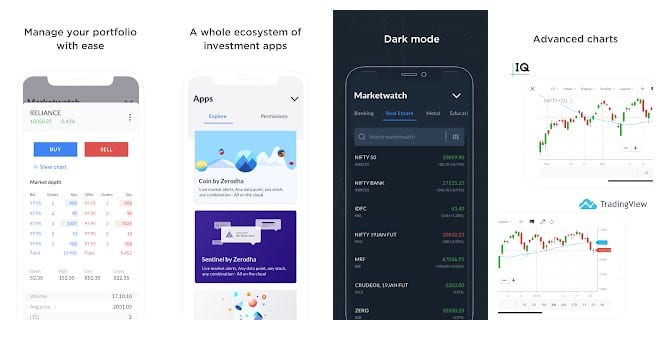The truth about zero-fee stock trading apps
 The Truth About Zero-Commission Stock Trading Apps
The Truth About Zero-Commission Stock Trading Apps
Mobile applications offering commission-free stock trading have revolutionized personal investment. These platforms eliminate brokerage fees associated with buying and selling securities, making investing more accessible to a wider range of individuals. However, the absence of explicit commissions does not equate to entirely free trading. This exploration delves into the nuances of this business model, examining its implications for investors.
The rise of zero-commission trading apps can be traced to increased competition within the brokerage industry and advancements in technology that reduced the cost of executing trades. This shift has democratized investing to some extent, enabling smaller investors to participate in the market without significant upfront costs. However, understanding the revenue models employed by these apps is crucial for informed decision-making.
The following sections will examine the various revenue streams, potential hidden costs, security considerations, and strategies for utilizing these platforms effectively. The goal is to provide a comprehensive understanding of the realities behind the seemingly free service.

FAQs about Commission-Free Stock Trading Apps
This section addresses frequently asked questions surrounding commission-free stock trading platforms, clarifying common misconceptions and providing insightful answers.
Question 1: How do commission-free brokerage apps make money?
Commission-free platforms generate revenue through various methods that often remain invisible to the average user. These include payment for order flow (PFOF), where the app receives a payment from market makers for routing orders to them; interest earned on uninvested cash balances held in customer accounts; and data licensing, selling aggregated user data to market research firms.
Question 2: Are commission-free apps safe and secure?
The safety and security of any brokerage app depend on several factors including regulatory compliance, data encryption practices, and the overall financial stability of the platform's parent company. Reputable apps are subject to rigorous regulatory oversight, and investors should research the company's background and track record before using their services.
Question 3: What are the potential downsides of using a commission-free app?
While attractive, commission-free apps may offer fewer features than full-service brokers, potentially limiting research tools, customer support, or access to certain investment products. The reliance on PFOF can raise concerns about potential conflicts of interest, although regulatory scrutiny aims to mitigate these risks.
Question 4: Are there any hidden fees?
While the absence of per-trade commissions is a major draw, other fees might apply. These could include inactivity fees, account maintenance fees, or fees for certain services like options trading. Carefully reviewing the fee schedule is crucial before committing to an app.
Question 5: How do I choose the right commission-free brokerage app?
Selecting the appropriate app requires comparing features, fees, security measures, and user experience. Consider factors such as research capabilities, available investment options, customer support responsiveness, and the platform's overall reputation and regulatory compliance.
Question 6: What is the impact of payment for order flow (PFOF)?
PFOF is a common revenue model where brokers receive payment for routing customer orders. While this can benefit the broker, potential conflicts of interest exist because the broker might prioritize routing orders to the market makers that offer the highest payment, potentially at the expense of optimal execution prices for the investor.
The key takeaway is that while "free" is appealing, understanding the revenue mechanisms is vital for informed investing. Diligent research and a critical evaluation of the platform’s practices are crucial.
Tips for Utilizing Commission-Free Trading Apps Effectively
These tips highlight strategies for maximizing the benefits of commission-free platforms while mitigating potential risks.
Tip 1: Thorough Research: Before selecting a platform, research the company’s background, security protocols, and fee schedule. Compare different apps to identify the best fit for individual needs and investment style.
Tip 2: Diversify Investments: Avoid concentrating investments in a single stock or sector. Diversification mitigates risk and is a cornerstone of sound investment strategy, regardless of the platform used.
Tip 3: Understand Trading Fees: While commissions are absent, other fees might apply. Review the complete fee schedule to avoid unexpected charges.
Tip 4: Prioritize Security: Choose a platform with robust security measures, including two-factor authentication and encryption. Regularly review account statements for any unauthorized activity.
Tip 5: Use Limit Orders: Employ limit orders to buy or sell at a specified price or better, ensuring better control over transaction costs. This is particularly important in volatile market conditions.
Tip 6: Monitor Account Activity Regularly: Maintain consistent oversight of your account activity to identify any discrepancies or unexpected charges promptly.
Tip 7: Seek Professional Advice (if needed): For complex investment strategies, consider consulting with a qualified financial advisor for personalized guidance.
Effective utilization of these platforms hinges on informed decision-making and a proactive approach to risk management. By combining careful research with diligent monitoring, investors can leverage the benefits of commission-free trading while minimizing potential drawbacks.
Conclusion on Commission-Free Stock Trading Apps
This exploration reveals that while commission-free stock trading apps offer unprecedented accessibility to the market, a comprehensive understanding of their revenue models and potential hidden costs is essential. The allure of "zero commissions" should not overshadow the need for careful scrutiny of security measures, fee structures, and the potential conflicts of interest inherent in certain revenue generation strategies.
The future of investing likely involves continued innovation in brokerage technology, with a focus on enhancing transparency and minimizing potential conflicts of interest. Informed investors who prioritize research, security, and diligent monitoring will be best positioned to leverage these platforms effectively and achieve their financial objectives.

Published on: 2025-04-10T10:36:33.000Z
